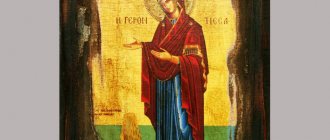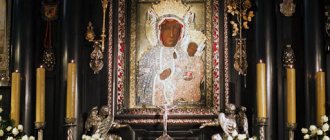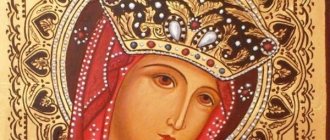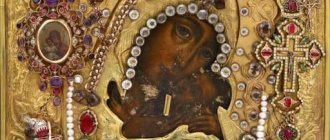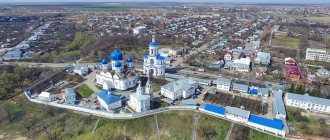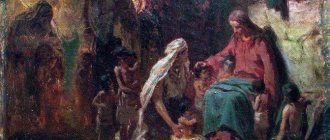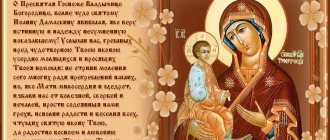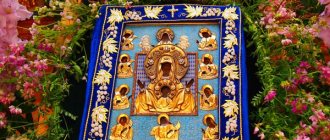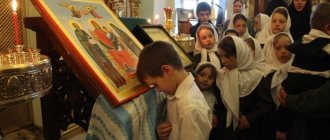Icon revealed in 1071
Celebration of April 25
Written, according to legend, by the Evangelist Luke. Appeared on April 25, 1071. There is no other information about her.
Copies of this icon are located in Moscow, in the parish church of the Dormition of the Blessed Virgin Mary, on Malaya Dmitrovka, in the village of Nizherovo, Rostov district, Yaroslavl province, and in the Spaso-Eleazarovsky monastery, 25 versts from Pskov. The original name of the Spaso-Eleazar Monastery was Sretensky - as a sign of the meeting of the Constantinople Icon of the Mother of God, which was brought to the monastery after the fall of Constantinople by the Monk Euphrosynus of Pskov, who received the copy from the Patriarch of Constantinople.
Troparion, tone 1
Arise to us, like a shining sun from the east in splendor/ Your icon, Lady,/ illuminating miracles with a glorious radiance/ of all who come to her with faith and love/ and praying to heartily towards Your greatness, even about Your Son and God./ Glory To God, who gave this to us through Euphrosyne!/ Glory to Him who brought you from Constantinople!/ Glory to Him who gives healing to everyone.
Kontakion, tone 8
The glorified Mother of the Most High / calls us to the chant of Her image by coming from Constantinople / and excites us with the vision of feat / to defeat the opposing forces / and to Her, as our joy of wines her, sing // rejoice, Unbrideless Bride.
| Constantinople Icon of the Mother of God, Palekh |
History and description
It is believed that the icon always chooses its own place of residence, and where this icon is located, God himself reigns. So one day, having left Constantinople, shortly before its death, the icon found its home in Russia.
The history of the Constantinople icon is full of secrets, disappearances and discoveries in new and new places.
The icon of the Spaso-Elizarovsky Monastery, once brought there by Father Euphrosynus from Constantinople in the 15th century, drowned in Lake Peipus during one of the Swedes’ raids. According to legend, it is believed that to this day this icon rests at the bottom of the lake, protecting these lands and all of Russia. Now in this monastery there is a copy of it, but how and where it came from is not known for certain. During the revolution of 1917, when the monastery was plundered, the icon was saved thanks to Elder Nicholas, who at that time served in a small monastery on the shores of Lake Peipsi.
Constantinople Icon of the Mother of God
The second image, created by Saint Luke and brought from Constantinople by two monks, is known for its miraculous power. Thanks to him, many people were healed from serious illnesses and through this suffering came to God.
Icon on a slate board
Celebration of September 17
The icon is engraved on a slate board and has very small dimensions - only 2 inches. Belongs to the iconographic type of Hodegetria.
Tradition tells about her appearance that in ancient times two Greek monks, passing from Constantinople, were in Staraya Russa and listened to the Divine Liturgy here in the cathedral church. As a reminder of their stay here, they left an icon of the Mother of God in the cathedral. This icon later became famous for many miracles and was kept in the Old Russian Cathedral.
LiveInternetLiveInternet
https://fotki.yandex.ru/users/kondoribbrat/view/300299/?page=0
In a letter dated May 14, 1641, Tsar Alexei Mikhailovich wrote the following about the Little Russian Cossacks or Cherkasy: “they came from the Lithuanian side to our Moscow state because the Polish and Lithuanian people violated their peasant faith, and destroyed the churches of God, and beat them, and burned their wives and children into mansions, and destroyed and plundered their courtyards and every building. And we, the great Sovereign, regretting that they were Cherkasy, Orthodox peasants of the Greek law faith and seeing them from the Poles in exile and in death, ordered them to be accepted under our royal high hand and ordered them to be settled.” It is known that after the Berestech defeat (1651), 10,000 Cossacks of the Ostrog regiment fled abroad and asked the Moscow Tsar to allow them to settle on Moscow soil. Following the Ostrozh regiment, people began to move to the Moscow state from other places in South-Western Rus', and in less than six months, in the space from Putivl to Ostrogozhsk, many settlements appeared, from which cities and rich towns were formed: Sumy, Lebedyan, Belopole, Korocha and etc. By 1654, the number of Cossack settlers reached 80 thousand. These Cossack immigrants settled on the outskirts of the Moscow state, including in the current Sudzhansky district, they usually settled in separate settlements, which over time turned into cities. In one of the letters of Peter I, given in 1705, September 1. in the name of Colonel of the Sumy Regiment Andrei Gerasimovich Kondratiev, about the original settlers of the Cossacks or Cherkasy it is said this way: “in past years, grandfathers and fathers and brothers, and their relatives came under our high-powered hand on this side of the Dnieper and those newly arrived Cherkassy built the cities: Sumy, Sudzha, Miropolye, Krasnopolye, Belopole and to those cities - counties, villages and hamlets." Here, villages and hamlets built in past years near the city of Sudzhu mean areas close to the city, inhabited by the same Cossacks. These areas could be Ulanok, Cherkasskaya Konopelka and other villages located 8 - 12 versts from Sudzha.
Church of the Nativity of Christ in the village of Ulanok, Sudzhansky district
In addition, in the deed of gift given by Tsar Alexei Mikhailovich, among other villages that were granted some benefits, Ulanok is mentioned as an independent village in Sudzhansky district, Sumy province. It is to this time (the reign of Alexei Mikhailovich) that the final formation of Ulanka as a separate village should be attributed. Its original population consisted of the same people - Cherkassy from different places of South-Western Rus', mainly from the current Kyiv, Volyn, Poltava and Chernigov provinces. The current Church of the Nativity in the village of Ulanok was built in 1862. Before its construction, there were two more churches in the village. The chronicle of the village tells: “old people say that the temple was wooden and bought in the town of Baturin (Chernigov province); This temple burned down, but why and when exactly is unknown.” No information has been preserved about the interior decoration of the temple and its iconostasis. We have more information about the second temple: it was purchased in the city of Summa (Kharkov province) and presumably built between 1774-1780, had three domes. There were 15 icons in the temple, of which 11 were in the church itself, 3 in the altar, and 1 in the vestibule. Some information about the iconostasis has been preserved: “in the church itself the iconostasis was wooden with gilded carvings; the field on the iconostasis was blue; According to custom, there were three doors in it: royal, northern and southern. The width of the entire iconostasis was 10 arshins.” On both sides of the iconostasis there were two icon cases. On the right side was placed the image of the Savior and the Akhtyrka Icon of the Mother of God, on the left side was the image of Nicholas the Wonderworker (in a precious embroidered robe). Most likely, the iconostasis was single-row or (less likely two-row), presumably consisting of eight icons. By the middle of the 19th century, the temple had become so dilapidated that it was decided to build a new stone temple, which still exists today. One of the main shrines of the temple was the icon of the Mother of God “Pasovskaya-Tsaregradskaya”. Chronicle about the icon. Ulanka narrates: “From time immemorial, this icon was in the house of a parishioner, landowner, titular councilor I.F. Nikiforova and was the property of the Nikiforov family. As a result of the miraculous healing shown by this icon for the daughter of the above-mentioned landowner, many of the parishioners began to resort to her in their illnesses and sorrows, and those who came running with faith and warm prayer received healing and consolation. The news of the healings received from the miraculous image of the Mother of God soon spread throughout the surrounding villages, and people from different places began to come to the house of the said landowner, and since it was inconvenient to have this famous shrine in a private house, before the founding of the current church in 1850, it was granted to the church by the son of the above-mentioned landowner, P.I. Nikiforov, and then a silver robe worth 8 pounds, worth 400 rubles, was built for her with voluntary sacrifices.”[5]. As for the appearance of the icon, the chronicle is silent about this, although some data is still available: “The icon is painted on linen glued to a board, in a silver robe with a gilded crown around the head of the Mother of God; The icon is 1 1/4 arshins (88.88 cm) long and 3/4 arshins (53.34 cm) wide.”
About the history of the village. Ulanok is narrated by the “Chronicle of the village of Ulanok, Sudzhansky district,” compiled by priest P. Chuzhimov at the beginning of the twentieth century. It contains information about the history of the village, temples that were built at different times in the village, folk customs, level of education of residents, village priesthood, etc. We provide complete information about the formation of the village: “No reliable news has been preserved about the ancient, until the 17th century, population of the area currently occupied by the village of Ulanok. Based on the existence of mounds in the Sudzhansky district and, in particular, on the Ulankovsky field, it is believed that this area shared a common fate with the entire Kursk region, namely: it was repeatedly destroyed from the 13th to the 16th centuries. was devastated by Tatar raids. Since the 17th century Little Russian Cossacks or, as they were called then, Cherkassy, began to populate this area. These were immigrants from different places in Southwestern Rus', mainly from the current Volyn, Kyiv, Poltava and Chernigov regions. The circumstances that influenced the resettlement of these people from Southwestern Rus' were of an ecclesiastical and political nature. It is known that the 16th and 17th centuries. were difficult times for the Orthodox of Southwestern Rus'. Having fallen politically under the rule of the Lithuanian-Polish princes, South-Western Rus' had to experience severe disasters in religious and church terms; it was a time of bloody persecution brought about by the Lithuanian-Polish princes and the Catholic Union against Trans-Dnieper Orthodoxy. With the advent of the Jesuits in the Polish-Lithuanian kingdom (1561), Orthodox Christians who were subjects of Poland were subjected to terrible oppression, and those Russians who did not agree to betray their paternal faith were deprived of all rights and civil benefits there: they were tortured in the courts, their houses were burned, their churches were handed over to the Jews. At that time, the order to the Volyn ambassadors (1645) states: “the Greek faith endured such violence in the Catholic Christian state, in the free and free Polish-Lithuanian Commonwealth, which the Greek Christians did not experience in filthy captivity: churches, monasteries and departments were taken away from the Orthodox, the free exercise of worship was prohibited by them, and poor Christians died without the sacraments; Orthodox Christians were forbidden to be buried in public.” It is enough to recall the names of Josaphat Kuntsevich and Hypatius Potsey - the worst enemies of Orthodoxy - to judge the situation in which the unfortunate Orthodox of South-Western Rus' were; the first of them took away churches and monasteries from the Orthodox, and the second went so far as to imprison Orthodox priests, shaved the beards and heads of others, often, accompanied by servants, broke into Orthodox churches, tore off altars with his own hands, robbed church utensils and took away with him the holy . antimins. Driven to the extreme by such measures, the Orthodox Christians of South-Western Rus', constrained in their civil rights, began to move from the Polish possessions beyond the Dnieper to save their lives and faith, first individually or in families, and then in hundreds of families. The Moscow kings willingly accepted these sufferers of Orthodoxy, often out of compassion for them, and often because of the benefits for their kingdom.
in the vestibule of the temple, above the entrance, a painting has been preserved, representing the image of the Pasovskaya icon, which is held by two kneeling angels
Another shrine of the Church of the Nativity of Christ was a throne made of cypress sent from the Holy Mountain. The chronicle says that this cypress was personally planted on Mount Athos by St. Equal-to-the-Apostles Emperor Constantine the Great (IV). 2.2. New information about the icon. After the October revolution, the Pasovskaya-Tsaregradskaya icon was lost. By a happy coincidence, in the vestibule of the temple, above the entrance, a painting has been preserved, representing the image of the Pasovskaya icon, which is held by two kneeling angels. In addition to the painting, an inaccurate copy of the early 20th century, in a frame frame, has survived. From these two surviving images we can get an idea of the composition of the icon and its belonging to a certain iconographic type. In 2002, the Department of Restoration of Easel and Monumental Painting of the KhSADI received from a private collection for restoration an icon of the Mother of God, strikingly close both in its iconographic type and in size to the sought-after Pasovskaya icon. This is also supported by the presence of holes from the nails with which the flashing was attached. Conclusions. Historical materials regarding the village. Ulanok contain information about the emergence of the village, the time of construction of the temple, the time of transfer of the Pasovskaya-Tsaregradskaya icon to the temple, as well as some information about the interior decoration of the temple and its iconostasis. All of the above allows us to make the assumption that the icon from a private collection is the same Pasovskaya icon. 3. Research part. 3.1. Description of the icon of the Mother of God “Pasovskaya-Tsaregradskaya”. Even with a superficial examination, the unusualness of the iconography immediately catches the eye. The icon is close to the iconographic type of Eleus. Half-figure image of the Mother of God and Child. The baby is depicted standing on the right side of the Mother of God. With his left leg he rests on the left knee of the Mother of God. He threw his right leg over Her left hand. It seems that the Baby is climbing up to cling to the cheek of the Virgin Mary. With his right hand, the Infant God holds the Mother of God by the chin. With her left hand, the Mother of God supports the Baby under the thigh, and with her right hand she presses him to her. The Mother of God is depicted with her head uncovered. Her red maforium, decorated with golden flowers, flows down in loose folds. Tunic of deep blue-green color. The baby is dressed in white clothes. 3.2. Theotokos icons and iconography of Eleusa. The veneration of the Mother of God, as an intercessor and mediator between the heavenly world and the earthly world, dates back to the very beginning of the Christian church. This veneration was expressed both in secret prayer and Akathists (i.e. in the word), and in architecture and icon painting. If the icon of Christ, the basis of Christian image-making, conveys the features of God who became Man, then in the icon of the Mother of God we have the image of the first man who realized the goal of the incarnation - the deification of man. The Orthodox Church affirms the blood connection of the Mother of God with fallen humanity, bearing the consequences of original sin; she does not distinguish Her from the offspring of Adam. But at the same time, Her exceptional dignity as the Mother of God, Her personal perfection, the highest degree of holiness She achieved, explain Her exceptional veneration. Of the entire human race, She was the first to achieve the goal that is set for all people - the complete transformation of all human nature. She is the only one of all created beings who has already crossed the line that separates time from eternity, and is already now in that Kingdom, the coming of which the Church awaits after the second coming of Christ. “Having contained the inconceivable God,” “truly the Mother of God,” so solemnly proclaimed the Third Ecumenical Council (Ephesus, 431). She, together with Christ, rules the destinies of the world. Therefore, Her icons occupy a particularly significant place for us: in the temple and worship, their place is along with the icons of the Savior. Icons of the Mother of God differ from icons of other saints and icons of angels, both in the variety of iconographic types, and in their number and intensity of veneration. Church Tradition attributes the first icons of the Mother of God to Saint Luke the Evangelist, which were painted by him after Pentecost, during the life of the Most Pure One. As a rule, we are talking about three icons: “Hodegetria”, “Eleusa” and one more icon, the exact type of which has not been established. Perhaps it was an icon close to the image of the Mother of God in the Deesis, i.e. turned to Christ in prayer. Other sources indicate that this was an image of the Mother of God close to the Cyprus icon. Currently in the Russian Church there are about ten icons, the authorship of which is attributed to the Evangelist Luke; in addition, there are twenty-one of them on Mount Athos and in the west, of which eight are in Rome. Of course, all these icons are attributed to the Evangelist not in the sense that they were written by his hand; Not one of the icons he himself painted has reached us. Authorship of St. Evangelist Luke must be understood in the sense that these icons are copies of icons once painted by the Evangelist. Sacred tradition tells that when the Evangelist Luke showed his icons to the Mother of God, she said: “From now on, all generations will bless me,” “Let my grace be with this icon!” Thus, the Mother of God herself blessed the painting of Her icons. In addition to the icons of the Evangelist Luke, there was also a lifetime icon of the Mother of God, not made by hands. Its history is as follows: the Holy Apostles Peter and John the Theologian visited the city of Lydda (later called Diospolis) and erected a temple there in the name of the Most Pure Mother of God. Returning to Jerusalem, they begged the Mother of God to come to Lydda and bless the temple, to which She replied: “Go with joy, I will be there with you.” The apostles returned to Lydda and saw a miraculous image on one of the pillars. Her face and clothes were completely similar to reality. Then the Mother of God Herself visited the Lydda Temple and bestowed grace and the power of miracles on the image. In the 4th century, Emperor Julian the Apostate, a persecutor of Christians, ordered the destruction of the Lydda image, but when trying to scrape off the image, the paint cut deeper and deeper into the depths of the pillar.
Eleusa (example)
In the 8th century, Patriarch Germanus of Constantinople (714-730), while on a trip to holy places, visited the Lydda Temple. At his request, a copy was made from the Lydda icon, which Blessed Herman took with him to Constantinople. When Leo the Isaurian ascended the imperial throne and persecution of icon worshipers began, Patriarch Herman was sent into exile. Anticipating his imminent death and fearing that the iconoclasts would destroy the icon, he cut a hole in the board of the icon, inserted a letter to Pope Gregory II the Saint (715-731) into it and threw the icon into the sea. The next day the icon was already in Rome. Pope Gregory had a vision in a dream about the miraculous appearance of the icon, and he went out with his retinue to meet the icon, which was floating in an upright position in the waters of the Tiber to meet the pope. The icon stayed in Rome for one hundred and twelve years. In 842, Michael reigned in Constantinople, and icon veneration was restored. Then the Lydda Icon rose into the air, flew out of the church, and, plunging into the waters of the Tiber, sailed from Rome to Constantinople, where it was found at the pier near the imperial palace. Since then, this icon has also been called Roman. As for the miraculous icon, the last mention of it was found in the 9th century. Judging by the lists, this image belonged to the “Hodegetria” type. Of the oldest surviving images of the Virgin Mary, catacomb frescoes occupy a special place. For example, in the catacombs of Priscilla (2nd century) the image of the Virgin Mary is still purely Hellenistic in form. To indicate that this woman is the Mother of God, we had to resort to external signs. These external signs are the Old Testament prophet next to Her and the star above Her head. We see here the same principle as in allegorical images of the Eucharist: in order to show that the image, be it a meal, a scene of consecration, or simply bread and wine, represents the main Christian sacrament, an external sign was added to it, the Eucharistic symbol of the fish, and this detail switched the meaning of the image to another level, illuminated it as if from the inside with saving content. It’s the same here: to show that the woman depicted is not an ordinary mother, but the Mother of God, external indications were needed - a star and a prophet. The latter holds in his left hand a scroll or book with his prophecy; with his right hand he points to the star above the Mother of God. Some researchers believe that this is Isaiah, based on his words: “The Lord will give you eternal light,” for the star is a symbol of heavenly light. Others believe that this is Balaam in connection with his words: “A star will rise from Jacob, and a rod will arise from Israel” (Num. 24:17). The veil on the head of the Mother of God is a distinctive sign of a married woman, which She was according to Her social status. The veil is therefore a feature of historical realism, which has been invariably preserved to this day in the Orthodox iconography of the Mother of God. This image is both historical and symbolic, and this combination of historical realism with symbolism lies at the basis of church art. In most monuments before the 5th century, plot-narrative compositions predominate in the iconography of the Mother of God. As N.P. Kondakov writes: “We see now a young mother, now an elderly matron or a young patrician.” Until the 5th century, images of the Hellenistic circle were replete with excessive narrative images, and the Virgin Mary was often depicted as a noble Roman lady with earrings, a necklace, and a characteristic hairstyle. After the Council of Ephesus (5th century) and the transfer of the image of the Mother of God to Constantinople in 458 from Jerusalem and its position in the Blachernae Church, images of the Mother of God are strictly regulated. Cycles of chants dedicated to the Mother of God were created, the authors of which were: Roman the Sweet Singer (VI century), Andrei of Crete (VII - VIII century), John of Damascus (VIII century), Patriarch Sergius of Constantinople (VII century), Kozma Mayumsky (VIII century). V.). These chants served as the basis for many icons. “Akathist”, composed by Patriarch Sergius, takes on special significance in this context. In the light of our research, we are most interested in the iconographic type of Eleus, since the Pasovskaya icon belongs to this iconographic type. Eleusa - Merciful. In Russian iconography, the name “Tenderness” is widespread. Church tradition claims that the first icon of “Tenderness” was painted by the Evangelist Luke and this icon is now known as the “Vladimir” icon. Description: half-length image of the Mother of God. On Her right hand sits a Baby. He pressed his left cheek to the right cheek of the Mother of God. The left hand of the Blessed Virgin is directed towards the Child. His right hand is extended to the left shoulder of the Mother of God, and with his left hand he clasps Her neck. The left leg of the Infant Christ is bent so that the sole of the foot is visible, which in subsequent times becomes a mandatory feature of the iconography of this image. This type was widespread in Byzantium in the 11th century. After the transfer of Eleusa in the 12th century from Constantinople to Kyiv, this type began to spread to Rus'. Initially, the icon was placed in Vyzhgorod near Kiev, where the icon became famous for many miracles. In 1155, Andrei Bogolyubsky transferred the icon to Vladimir, where it received its name. In 1395, the icon was transferred to Moscow to pray before it for salvation from the invasion of Tamerlane. After this, the icon did not return to Vladimir. A list of Andrei Rublev's work was sent to Vladimir. In 1451, the Mother of God, through the icon, saves Moscow from the invasion of the Nogai prince Mazovsh. In addition, two more cases of the intercession of the Mother of God for Moscow through this icon are known: In 1408 - the raid of the Horde khan Edigei, and in 1521 - the invasion of Muhammad-Girey. According to N.M. Tarabukin, it was after Edigei’s raid that the iconographic type became widespread in the Moscow lands. The most famous varieties of Eleusa include the icons of the Mother of God: “Donskaya”, “Korsunskaya”, “Igorevskaya”, “Pochaevskaya”, “Kasperovskaya”, “Glycophelussa”, “Kikiotissa”, “It is worthy to eat”. Among the icons of the Mother of God belonging to the iconographic type of Eleusa, revered in Sloboda Ukraine, the “Korsun-Shpilevskaya” icon (Sumy) should be mentioned.
3.3. Analysis of iconography. The icon called “Pasovskaya” is not mentioned either in the most complete reference book of the Virgin Mary icons of the Villager, or in the book by S. Snessoreva, or in other similar publications. But they contain the name “Constantinople” icon. More precisely, they contain mention of two especially revered icons and three locally revered ones; the first, especially revered icon of the Mother of God “Constantinople, according to legend, painted by St. Evangelist Luke, then revealed on April 25, 1071. The second, the “Constantinople” icon, also dating back to 1071, was located in the cathedral church of the city of Staraya Russa, Novgorod province. According to legend, it was left in the cathedral by two Greek monks who arrived from Constantinople. It is engraved on a slate board and is small in size. Belongs to the iconographic type of Hodegetria. Of the three locally revered, the first belongs to the iconographic type of Panagia Dex, located in Moscow. The second is located in the Spaso-Elezarovsky Monastery of the Pskov Diocese, the third in the village of Nizhegorov, Yaroslavl province. Judging by the descriptions presented, not one of these types has anything in common with the “Pasovskaya-Constantinograd” icon. One can only assume the Greek origin of the iconography. When analyzing the iconography, some special details catch the eye. One of them, the Virgin Mary, is depicted with her head uncovered. This feature is not typical for Orthodox icon painting and, accordingly, is extremely rare. According to the general rule of Eastern icon painting, the head of the Mother of God is covered with a veil, both as a sign that she is not only a Virgin, but has already given birth, and so that Her type is consistent with the custom of not appearing to women for prayer with their heads uncovered. However, even in the painting of the catacombs of the 1st and 2nd centuries. The Virgin Mary is written in two ways, both with her head covered and with her head uncovered, as, for example, in the catacombs of Priscilla. The uncovered head of the Mother of God can be explained by the desire to show Ever-Virginity. Perhaps the most famous icons where the Virgin Mary is bare-haired are the Moscow image “Seeking the Lost,” the image of the Virgin Mary of Akhtyrka, known since the 17th century. But apart from this similarity, there is nothing similar between the “Pasovskaya” icon and these icons. The second feature - the position of the Baby, who seems to be climbing up, pressing against the cheek of the Virgin Mary, has no analogues in Russian iconography. The chronicle of the village of Ulanok mentions that the village was founded in the 17th century by Ukrainian Cossacks. It also says: “As the descendants of the Little Russian Cossacks, who from time immemorial were distinguished by their deep devotion to the faith and the church, the current parishioners have retained the same devotion to the faith. Not a single case has been preserved either in the chronicles or in the people’s memory, not only of any falling away from the church into sectarianism or schism, but even of simple religious error.” Based on these lines, it is not surprising that the inhabitants, distinguished by such piety, had strong ties with the Athos monasteries. We find confirmation of this in the same Ulankov chronicle - in 1860, for the newly built temple, through the labors of Athonite monks, cypress boards were sent to Ulanok for the construction of the throne, a gift of special value, because This cypress was planted with his own hands in the 4th century by St. Equal-to-the-Apostles Emperor Constantine the Great. Thus, given the indisputability of connections with. Ulanok with Greece, the presence of such a rare image here does not seem so incredible. So, the Greek origin of the icon says: 1. The name “Tsaregradskaya”. 2. Elements of iconography that are uncharacteristic of the Russian icon (the uncovered head of the Mother of God). This element is characteristic of images of the Latin church, but is also found in Greek icon painting under the influence of Italian art. Of particular interest are the analogues of the iconography that interests us. In particular, three analogues that we discovered as a result of lengthy searches. The first analogue is given by N.P. Kondakov. This analogue differs in many ways from ours, but still it allows us to clarify some points that interest us. It dates back to the 16th century. and is located in the Greek Church of Messina. Kondakov suggests his Athonite origin. This icon is like a mirror image of the Pasovskaya icon. The position of the feet of the Infant God is similar. The position of the Baby’s left hand (there is a scroll in it) is excellent; the head of the Mother of God is covered with maforium. Even more interesting is the analogue, which is a Romanian folk icon (glass, oil). Here we are dealing with an almost identical composition, although there are still differences: the head of the Mother of God is covered with a white and blue cloth (in accordance with the Orthodox tradition), on top of the cloth, the head of the Virgin Mary is crowned with a crown, the same crown crowns the Infant of God, the Child is depicted naked, which is borrowing from the Latin tradition. Romania, as a country of the Byzantine circle, received Greek iconographic types. There were Romanian Orthodox monasteries on Mount Athos, which certainly played an important role in the spiritual life of Romania. Let us at least recall the fact that Romania played an important role in the revival of canonical icon painting in the Russian Empire. The analogue we presented is also rare for Romanian icon painting, so, most likely, the Romanian master worked from imported samples, possibly from Greek ones. The third and most valuable analogue is the icon discovered in a private collection. It is completely identical in iconography. Moreover, it is identical in size. By the nature of the writing, this is an example of Ukrainian icon painting of the 18th century, but if we take into account the above material, we can assume that there was a Greek source here. Unfortunately, all the inscriptions on this icon that could have brought some clarity have been lost. But it is still incredible that in Sloboda Ukraine (the village of Ulanok also belongs to Slobozhanshchina, although now it is the territory of the Russian Federation) there would be two such rare images. March 18, 2011, 10:45 pm 3.4. Description of the painting technique and the condition of the icon before restoration (based on visual research). The base is wooden, hardwood, presumably linden. Wood fibers are arranged vertically. The size of the icon is 87cm * 62.8cm * 2cm. Dowels - counter, mortise, figured, made from the same type of wood as the entire base. Number of keys - 2. The keys are movable. On the front side, the paint layer does not approach the edges of the base, so a wooden frame 3.5 cm wide is formed around it. Most likely, this part of the base, not covered with a paint layer, was intended for attaching the frame (or for attaching it to a frame iconostasis) . This is evidenced by holes for mounting chops, 0.5 cm in diameter, located around the perimeter. The distance between the holes is approximately 13.2 cm. There are five holes at the top and bottom, eight at the right and left. There is warping of the base caused by shrinkage of the latter, as well as numerous damages and losses caused by the activity of the borer beetle. General old soiling on the back of the base is dark grey. Pavoloka was not found. There is no soil as such. Most likely, the primer in this case is the sizing of the board. The paint layer is an oil painting that has a smooth surface. The structure of the painting layer is close to the three-layer method. No traces of a preparatory drawing were found. The green background represents the imprimature on which subsequent layers of paint are placed. The painting of clothes and faces is done in two stages: the first layer - clothes and faces are revealed with colors that are a tone lighter and cooler than expected, and then finished with generalized glazes. The exception is the painting of maforia, made using the alla prima technique. Traces of silvering, silver tinted with yellow-brown varnish, have been preserved on the halos and decorative elements, on the maforia of the Virgin. Silver plating is done on Gulfarba. Gulfarba color is ocher. The paint layer has numerous losses, abrasions, and various types of contamination. 3.5. Stylistic features of the icon of the Mother of God “Pasovskaya-Tsaregradskaya”. The icon of the Mother of God “Pasovskaya-Tsaregradskaya” contains pronounced signs of the Rococo style inherent in Ukrainian icon painting of the first half of the 18th century. These features include the maforia decor, which has expressive rock features - flowers with twisted “C”-shaped stems. These flowers are an indication of the flourishing rod of Aaron, according to Mariological interpretations of the Old Testament symbols. Following the Rococo artists, the icon painter depicts forms of clothing unusual for Orthodox iconography, reminiscent of medieval attire. Another characteristic feature of the Rococo style is the giving of portrait characteristics to the depicted characters. In this case, we observe the characteristic features of the Ukrainian female type. If we consider the Old Testament from the perspective of Mariological interpretations, the iconography of the Pasovskaya Icon draws an analogy with the Ark of the Covenant. In the Ark of the Covenant, the tablets of the law intervened: from the ark of the shrine of the Most Pure Virgin, the Lord Lawgiver Himself appeared. The analogy with the Ark is emphasized by the cherubs depicted on the sides. Instead of images of formidable guardian cherubs, the icon painter places putti heads, popular in Rococo painting. In terms of painting technique, the characteristic features of Rococo include the use of silver. Silver was almost never used in Baroque icon painting. At this time, the technique of glazing on gold and silver was spreading in Ukrainian icon painting [8], which is observed in the icon under study. Conclusions. The “Pasovskaya-Tsaregradskaya” icon, which came from a private collection, can be called with full confidence the same icon that until 1917 was in the Holy Nativity Church in Ulanok. This statement is supported by: 1. The size of the icons is identical to the desired one. 2. Presence of nails from fastening the flashing. 3. The similarity of the iconography with the “Pasovskaya - Tsaregradskaya” icon depicted above the entrance in the narthex of the temple (wall painting). Some discrepancies with the chronicle of a technical and technological nature, in particular: the base material is cypress, and the presence of pavolok (as it is written in the chronicle: “the icon is written on canvas”), can be explained by the fact that the priest who wrote the chronicle at the beginning of the twentieth century was based at description of the icon is not based on personal observations or the opinion of experts. Already when the icon was transferred to the temple in 1862, the icon was covered with a frame and placed in an icon case (which corresponds to the chronicle), so there was no opportunity to examine the icon. So, considering the geography of the distribution of our iconography, we, one way or another, come into contact with Athos, which allows us, with a certain degree of probability, to draw a conclusion about its homeland. On August 10, 2003, on the day of the celebration of the Smolensk Icon of the Mother of God, Metropolitan Yuvenaly of Kursk and Rylsk celebrated the Divine Liturgy in the Holy Trinity Church in the city of Sudzha on the occasion of the discovery of the Pasovskaya (Constantinople) Icon of the Most Holy Theotokos, which had been venerated in the Kursk diocese since ancient times. Through the labors and care of believers, the venerated image of the Most Pure Virgin was found in Ukraine and returned to the Kursk diocese. During the holiday, a religious procession took place from the Pasovskaya Icon of the Mother of God, by which the miraculous image was delivered to the Church of the Nativity of Christ in the village of Ulanok, Sudzhansky district, where it had previously resided. The celebration of the icon takes place on September 17 according to the old style (September 30 according to the new style).
Church of the Nativity of Christ in the village of Ulanok, Sudzhansky district
Now this church is operational, restoration work is going on inside. The photographs were taken in early April of this year, 2012.
And this is in the evening of the same day. Work is still in progress. The windows mysteriously resemble stained glass, but this is a play of scaffolding inside and light.
Church of the Nativity of Christ in the village of Ulanok, Sudzhansky district
Thanks to Andrey Kondrashov and his website (link at the very top)
The post turned out to be a bit long, but informative.
CHRIST IS RISEN !
Used materials
- Evgeniy Poselyanin. Our Lady. Description of Her earthly life and miraculous icons. — M: ANO “Orthodox Journal “Christian’s Rest””, 2002:
- - April
- - May
- - September
:
